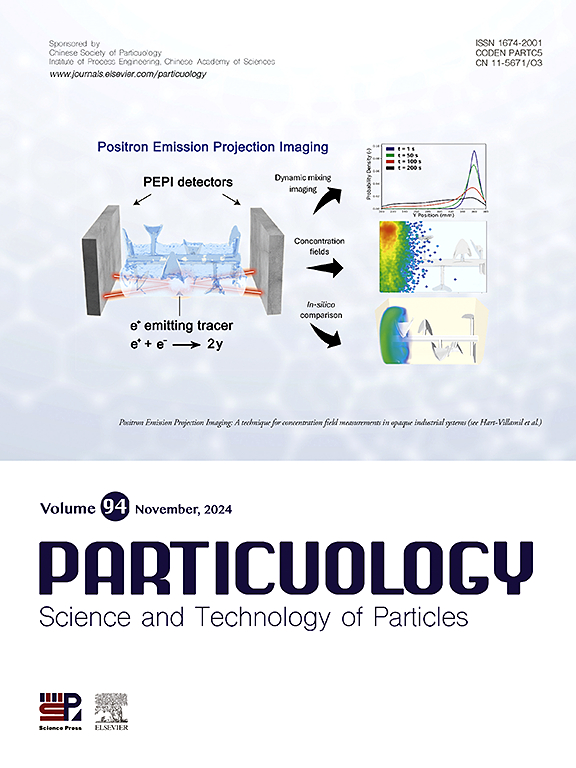Investigation of the particle-loaden filtration performance for real fibre media using CFD-DEM
IF 4.1
2区 材料科学
Q2 ENGINEERING, CHEMICAL
引用次数: 0
Abstract
In this paper, the particle-loaden filtration of real fibre media was numerically studied using computational fluid dynamics (CFD) and discrete element method (DEM) method. The filtration performance was comprehensively analysed by combining fluid and particle properties into a single dimensionless number, Stokes number (). The results indicated that the capture efficiency increased with until it stabilised at a certain limit value, which was in good agreement with the results of the previous empirical laws, confirming the accuracy and reliability of the CFD-DEM algorithm. In addition, the capture contribution of fluid and particle properties were investigated. It was found that increasing particle size and density was effective in improving capture efficiency. Moreover, reducing fluid viscosity was the most favourable condition for improving filtration performance. For the dynamic filtration of particle size 2–4 μm, the evolution of the capture efficiency and the pressure drop for = 4 μm was higher than that of other particle sizes due to the easy formation of the dendrite structure. In terms of the quality factor, the fibre layer exhibited a better filtration performance for particles with a diameter of 4.0 μm. This study provided a good understanding of dynamic particle-loaden filtration, which is useful for the optimal design of fibre filters.

用CFD-DEM研究真实纤维介质的颗粒负载过滤性能
本文采用计算流体力学(CFD)和离散元法(DEM)对真实纤维介质的颗粒负载过滤进行了数值研究。通过将流体和颗粒性质结合成一个无量纲数Stokes数(St),综合分析了过滤性能。结果表明,捕获效率随着St的增加而增加,直至稳定在某一极值,这与以往经验规律的结果吻合较好,证实了CFD-DEM算法的准确性和可靠性。此外,还研究了流体和颗粒性质对捕获的贡献。结果表明,增大颗粒尺寸和密度可有效提高捕集效率。降低流体粘度是提高过滤性能的最有利条件。对于粒径dp= 2 ~ 4 μm的动态过滤,由于易于形成枝晶结构,dp= 4 μm的动态过滤效率和压降的演变高于其他粒径的动态过滤。在质量因子方面,纤维层对直径为4.0 μm的颗粒具有较好的过滤性能。该研究为动态颗粒负载过滤提供了更好的理解,为纤维过滤器的优化设计提供了依据。
本文章由计算机程序翻译,如有差异,请以英文原文为准。
求助全文
约1分钟内获得全文
求助全文
来源期刊

Particuology
工程技术-材料科学:综合
CiteScore
6.70
自引率
2.90%
发文量
1730
审稿时长
32 days
期刊介绍:
The word ‘particuology’ was coined to parallel the discipline for the science and technology of particles.
Particuology is an interdisciplinary journal that publishes frontier research articles and critical reviews on the discovery, formulation and engineering of particulate materials, processes and systems. It especially welcomes contributions utilising advanced theoretical, modelling and measurement methods to enable the discovery and creation of new particulate materials, and the manufacturing of functional particulate-based products, such as sensors.
Papers are handled by Thematic Editors who oversee contributions from specific subject fields. These fields are classified into: Particle Synthesis and Modification; Particle Characterization and Measurement; Granular Systems and Bulk Solids Technology; Fluidization and Particle-Fluid Systems; Aerosols; and Applications of Particle Technology.
Key topics concerning the creation and processing of particulates include:
-Modelling and simulation of particle formation, collective behaviour of particles and systems for particle production over a broad spectrum of length scales
-Mining of experimental data for particle synthesis and surface properties to facilitate the creation of new materials and processes
-Particle design and preparation including controlled response and sensing functionalities in formation, delivery systems and biological systems, etc.
-Experimental and computational methods for visualization and analysis of particulate system.
These topics are broadly relevant to the production of materials, pharmaceuticals and food, and to the conversion of energy resources to fuels and protection of the environment.
 求助内容:
求助内容: 应助结果提醒方式:
应助结果提醒方式:


